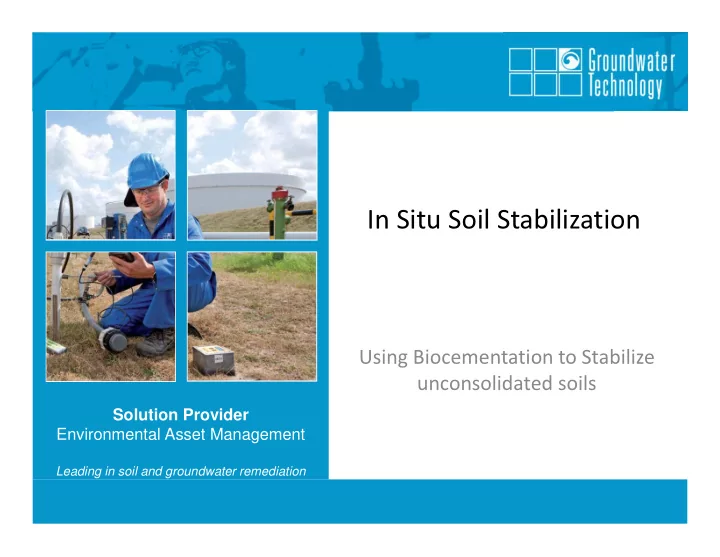

In Situ Soil Stabilization Using Biocementation to Stabilize Solution Provider bij bodemsanering unconsolidated soils Solution Provider Leading in soil and groundwater remediation Environmental Asset Management Leading in soil and groundwater remediation
In Siu Biostabilisation Unconsolidated loose soils often have poor physical properties: • Low natural slope angle • Low load-bearing capacity • Prone to subsidence / settlement • Prone to erosion • Prone to liquefaction Solution Provider Environmental Asset Management
Liquefaction Liquefaction occurs in saturated loose soils Pore water pressure in soil influences particle contacts: friction angle Normally: static pore water pressure conditions During earthquake: soil compacts -> rapid increase of excess pore water pressure -> particle contacts in soil reduced -> (complete) loss of strength: liquefaction San Fernando earthquake, 1971. Cassidy, J.F and others, Canada’s Earthquakes: Niigata, Japan,1964 ‘The Good, the Bad, and the Ugly’: Geoscience Canada, Volume 37 Number 1 Solution Provider Environmental Asset Management
CLASSIC SOLUTIONS • Dewatering to improve settlement • Surcharge for prolonged time to limit residual settlement • Physical mixing with bonding agents • Civil engineering solutions – Deep foundations – Sheet piling – Concrete piling Solution Provider Environmental Asset Management
IN SITU BIOCEMENTATION Increase bonding of soil particles: • Utilizing soil natural biological characteristics; • stimulating micro-organisms to catalyze chemical reactions; • precipitation of calcium carbonate (CaCO 3 ) to bind soil particles Conversion Catabolic reaction per mole CaCO 3 By products type Ammonium Urea hydrolysis 1 CO(NH 2 ) 2 + 2 H 2 O + 1 Ca(Cl) 2 → 1 CaCO 3 + 2 NH 4 Cl chloride Nitrate reduction 0.385 Ca(C 2 H 3 O 2 ) 2 + 0.615 Ca(NO 3 ) 2 → 1 CaCO 3 + 0.615 N 2 + 0,539 CO 2 + 1.159 H 2 O none with Calcium Sulphate Hydrogen 1 Ca(C 2 H 3 O 2 ) 2 + 2 CaSO 4 → 3 CaCO 3 + 1 CO 2 + 1 H 2 O + 2 H 2 S reduction sulfide From: Qualitative comparison of the suitability for bio grouting of several theoretical heterotrophic conversions using calcium acetate as organic substrate and several electron acceptors compared with urea hydrolysis (Van Paassen et al/ Ecological Engineering 36 (2010) 168 – 175.). Solution Provider Environmental Asset Management
BIOCEMENTATION PROVEN RESULTS Process is lab-proven and field- demonstrated; • Bio-consolidation controlled from 5kPa UCS (improved slope stability, less erodable) to high strength, 30MPa UCS (concrete: 20 - 70 Mpa)) by adapting the concentration and the number of treatments applied. • Application uses standard in situ remediation technologies Solution Provider Environmental Asset Management
BIOCEMENTATION PROCES Steps: 1. Analyze soils for suitability (pH, macro parameters, contaminants, toxicity) (optionally: do lab test) 2. Enrich local naturally occuring bacteria 3. Apply cultivated bacteria & amendments in treatment zone 4. Process takes between 1 week & 3 months Solution Provider Environmental Asset Management
Biostabilization Applications • reinforce embankments • prevent liquefaction and its damage • reduce building settlement and increase bearing capacity for foundations • stabilize the soil prior to trenching or underground constuction (eliminate over- excavation) • increase resistance to erosive forces of water flow (piping or surface erosion) Solution Provider Environmental Asset Management
Biostabilization Applications • provide additional stability needed to stabilize slopes • reduce sand production in oil or water wells (sand control) • create barriers that treat/clean groundwater as it flows • immobilize materials in the soil and prevent contamination of aquifers • create subsurface facilities for storage of liquefied natural gas or CO 2 • stabilization of gravels formation Solution Provider Environmental Asset Management
Examples Theory: Slope stability : Critical Circle Bishop Royal Boskalis Westminster nv Example calculation for project: a cohesion of ~16 kPa Materials Silty sand Dense Sand is sufficient to provide stability against (static) failure for a 4 m high, 1 in 2 slope in extremely loose sand. Papendrecht Rosmolenweg 20 T1 T1 This is a low strength application Erosion resistance: Fax Phone < 5kPa required (low strength application) Silty sand Maximum strength achievable: D-Geo Stability 15.1 : Talud 1 op 2 alleen cohesie.sti Annex 6-6-2017 30.000 kPa UCS (concrete: 20.000 - 70.000 kPa) date Xm : 55,71 [m] Radius : 8,93 [m] Ym : 5,00 [m] Safety : 1,52 Example of application Road bank along drainage canal Road surface Example of application Sea protection dam Underlaying aquifer prone to Road foundation (sand) liquefaction in case of earthquake Water Ancient dike Engineered Sheet piling Sea (water) & Constructed Dam Natural soil (clay & peat) Stabilization Sheet piling zone Aquifer (sand) Aquiclude (Tertiary clay) Solution Provider Environmental Asset Management
Thank you for Your Attention Groundwater Technology Sheffieldstraat 13 3047 AN Rotterdam Solution Provider bij bodemsanering Netherlands E-mail: yve@gtbv.nl info@gtbelgium.be Solution Provider Leading in soil and groundwater remediation Web: www.gtbv.nl www.gtbelgium.be Environmental Asset Management Tel: +3110 238 2850 Leading in soil and groundwater remediation Incident response: +3110 238 2868 Cell: +3165 391 6526
Recommend
More recommend